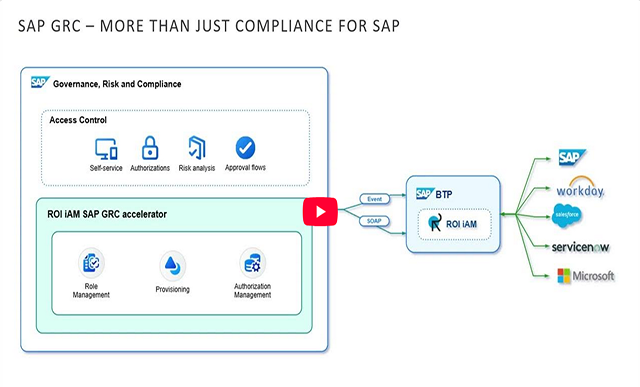Learn how the Cockpit for Documentary Payments can be used to facilitate international customers’ payment compliance, thereby reducing the risk of doing foreign trade. Follow steps to implement the Documentary Payments component in SAP sales and distribution (SD).
Key Concept
The Cockpit for Documentary Payments provides automated financial documents to facilitate payment guarantee procedures required to ensure that international customers trade transactions comply with the agreed-upon business terms. Some of these payment guarantee procedures are letter of credit, documents against payment (d/p) and documents against acceptance (d/a). The Documentary Payments component is fully integrated in the SAP sales and distribution (SD) - Credit Management component and it is under SAP ERP (Sales and Distribution – Foreign Trade).
In this era of globalization, the business requirement for foreign trade is increasing by the day. One major concern with organizations is the need to be able to enjoy guaranteed business-to-business international sales transactions where every party involved keeps to the agreed-upon business terms, especially the payment terms. This concern is more with foreign companies that engage in foreign trade with companies in developing countries. Based on this requirement, SAP has provided the Documentary Payments component that can help organizations achieve a high level of foreign trade payment compliance by providing an automated consistency check of sales transactions with agreed-upon financial documents. This data is leveraged to facilitate payment guarantee procedures required to ensure that international customers’ trade transactions comply with the agreed-upon business terms. This has helped these export organizations reduce payment risk by ensuring that payment is on time and in full.
Documentary payment is a business-to-business procedure used to guarantee the payment of goods when dealing with international sales transactions. It entails that the customer must present certain credible documents that can guarantee the payment of goods within a specific time frame. It is a kind of credit that is only relevant for international trade transactions.
The Documentary Payments component provides several payment guarantees, including letter of credit (L/C), open account (O/A), document against payment (D/P), document against acceptance (D/A), and cash against document (CAD). This article is not focused on how documentary payments procedures are transacted, but on how the Documentary Payments component is leveraged to achieve the objective of payment guarantees using the Cockpit for Documentary Payments.
The Cockpit for Documentary Payments is an interface that allows convenient access to the Documentary Payments component’s functionalities. Documentary payments are processes in which an exporter and an importer both reach certain terms of trade agreements and certain financial institutions such as the banks are used as intermediaries to guarantee, validate, and receive payments; issue instruments; and confirm documents on behavior of the exporter or importer.
Note
This article is focused on the letter of credit because it is the most secure way to obtain a payment guarantee. For more information on the different Documentary Payments procedures, get materials on payment guarantees for international trade.
How the SAP Documentary Payment Is Applied to Mitigate Payment Compliance Risk for Foreign Trade
The first thing to consider is what the likely risks scenarios faced by export organizations are. Here are some scenarios to consider:
- Goods can be shipped to a customer and the customer will not pay on time.
- Goods can be shipped to a customer and the customer will not pay completely.
- Goods can be shipped to a customer and the customer will not accept the shipment.
- Goods can be shipped to a customer and the customer may not be able to pay and then it becomes a bad debt.
These are some of the risk scenarios encountered by organizations especially dealing with customers in developing countries where there are no well-established standards for doing business, unstable government policies, a high level of corruption, or market instability. This causes such customers to be rated as high risks for credit.
How Is the SAP System Used to Enhance This Documentary Payment Process?
Although the documentary payment procedure is done outside the SAP system, the SAP Documentary Payments component provides features that make the payment procedures more effective and efficient.
A financial document is provided to facilitate the proper documentation of the required terms of the international trade. The financial document is also used as criteria to check the consistency of the sales transaction against the terms for the trade that is contained in the financial document, such as a letter of credit.
When processing sales transactions for foreign customers with a documentary payment, you need to create a financial document for the required payment guarantee. The SAP system carries out a consistency check between the relevant data in the financial document master record and the data in the sales order or outbound delivery transactions.
If the SAP system discovers any discrepancies, the sales order or delivery document is blocked. This blocked status does not allow further sales or outbound delivery transactions for such customers until a user with the authorization to release the blocked document releases the sales order or delivery documents. (The role of the user with the authorization to release a blocked sales order or delivery documents is to first inspect the transaction to ensure that the blocked sales order or the delivery documents data are updated with the appropriate data contained in the financial document assigned to the customer for that sales transaction before releasing the blocked document.) For example, if the payment terms, Incoterm (a shipping term used to convene shipping instructions in international trade), or the value of a sales order is inconsistent with that in the financial document assigned to the sales order, the SAP system with an active Documentary Payments component blocks such a transaction and the sales order cannot be processed for delivery.
Note
To further ensure more credibility to the process of verifying the consistency of the sales transaction for international customers with documentary payment terms, an extended confirmation control can be used in which a second user may be assigned the role to double-check and confirm the financial document.
How It Works: A Letter-of-Credit Business Scenario
Consider a scenario in which company ABX, which sells spare parts for cars in The Gambia, contacts company XYZ, which supplies spare parts for cars in Japan, with the interest to procure spare parts for cars from company XYZ. Due to the political tension as a result of the change of government in The Gambia, coupled with the fact that company ABX is a new customer, company XYZ rates company ABX as a high-risk customer for credit. Based on this credit rating, company XYZ invokes Documentary Payment using a letter of credit payment guarantee procedure as one of the business terms in the contract. This implies that when company ABX sends a purchase order, the following activities take place:
- Company XYZ confirms the order and sends an order confirmation to company ABX.
- Company ABX approaches its bank in The Gambia for a letter of credit.
- Company ABX’s bank (the opening or issuing bank) approves the letter of credit and contacts its branch, affiliate, or company XYZ’s bank (the advising bank, confirming bank, or negotiating bank) in Japan.
- Company XYZ’s bank verifies the authenticity of the document and if it is OK, sends the document to company XYZ and advises company XYZ accordingly.
- Company XYZ creates a financial document (letter of credit) according to the agreed-upon terms of the letter of credit in the SAP system using the SAP Cockpit for Documentary Payments.
- When the sales order is created in the SAP system for company ABX’s order, the SAP system checks the consistency of the relevant data in the sales order against the data in the letter of credit (financial document) already created in the SAP system. If there are inconsistencies, the sales order is blocked for proper investigation by authorized users. This also applies to the delivery document. The inconsistencies can be checked using the simulation functionality via the SAP Cockpit for Documentary Payments.
- Company XYZ ships the ordered spare parts to company ABX in The Gambia.
- Company XYZ contacts a negotiating bank (which can be the same as the advising bank) and gives the letter of credit with the required shipping documents.
- The negotiating bank verifies the documents based on the shipping condition in the letter of credit. If there are no discrepancies, the negotiating bank credits company XYZ with the agreed-upon value of the sales and may debit bank charges.
- The negotiating bank contacts and sends the shipping documents to company ABX’s bank in The Gambia in exchange for the amount the negotiating bank paid company XYZ in Japan and any possible bank charges based on the terms agreed on the letter of credit.
- Once company ABX’s bank receives the shipping document, the bank releases the document to company ABX based on their agreed-upon terms.
- Company ABX then uses the shipping document to clear and collect the goods from the shipping company in The Gambia.
The SAP Documentary Payments component provides the functionality that integrates the financial documents such as letter of credit to the sales transaction for a foreign customer and ensures that there is consistency between the sales transaction and the financial document as agreed. This further ensures that the negotiating bank will effect payment for the foreign transaction when due because of the consistency with the sales, shipping, and billing documents with the terms in the financial document such as a letter of credit that had already been validated in the SAP system.
Apart from providing this validation functionality, the SAP Documentary Payments component ensures that the data for the banks or financial institution involved in the transaction is maintained and that the required documents are correct and complete before the financial document is activated for use in a sales order.
Configuring the SAP Documentary Payment Component in SAP ERP
To configure the SAP Documentary Payment Component, you first set up the basic settings. In this first step, you define the financial document type.
Define a Financial Document
Financial documents in the Documentary Payments component are documents used to guarantee payment during international trade such as letters of credit, documents against payment, and documents against acceptance. The example used here is letter of credit.
To define the financial document type under Basic Settings, follow SAP IMG menu path Sales and Distribution > Foreign Trade/Custom > Documentary Payments > Basic Settings > Define Financial Document Type. Click the execute icon beside the Define Financial Document Type node to display a list of financial document types as shown in Figure 1.

Figure 1
The list of financial document types
To define a new financial document type, click the New Entries button or click the copy icon  . For my example, define the letter of credit financial document type by entering 05 in the Financial doc. type field and a name (Letter of Credit) in the Description field (Figure 2).
. For my example, define the letter of credit financial document type by entering 05 in the Financial doc. type field and a name (Letter of Credit) in the Description field (Figure 2).

Figure 2
Define a letter of credit financial document type
After inputting the required values, click the back icon  to return to the list of defined financial document types (Figure 3) and save your configuration by clicking the save icon
to return to the list of defined financial document types (Figure 3) and save your configuration by clicking the save icon  .
.

Figure 3
List of defined financial document types
Define Bank Functions
Bank functions are used to identify the different bank roles that will be allowed in the international trade transactions (such as opening bank or advising bank).
To define a bank function under Basic Settings, follow SAP IMG menu path Sales and Distribution > Foreign Trade/Customs > Documentary Payments > Basic Settings > Define Bank Functions. Click the execute icon beside the Define Bank Functions node to display a list of bank functions (Figure 4).
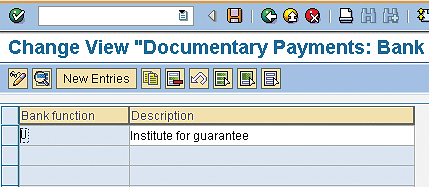
Figure 4
List of bank functions
To define a new bank function, click the New Entries button or click the copy icon. For my example, define the opening bank, advising bank, and negotiating bank functions. To define an opening bank, enter O in the Bank function field and Opening Bank in the Description field as shown in Figure 5.

Figure 5
Define a bank function
After inputting the relevant entries for the opening bank, click the next entry icon  to input other new bank functions. After defining the bank functions, click the back icon to return to the list of Defined Bank Functions and save your configuration by clicking on the save icon. Figure 6 shows the list of the defined bank functions.
to input other new bank functions. After defining the bank functions, click the back icon to return to the list of Defined Bank Functions and save your configuration by clicking on the save icon. Figure 6 shows the list of the defined bank functions.

Figure 6
List of defined bank functions
Define Documents to Be Presented
One payment guarantee feature of the Documentary Payments component is that documents for payment guarantee are required based on the terms of the letter of credit. The required documents can be set up in customizing and assigned to the appropriate letter of credit or any other payment guarantee financial document.
To define documents to be presented under Basic Settings execute transaction code VX57 or follow SAP IMG menu path Sales and Distribution > Foreign Trade/Customs > Documentary Payments > Basic Settings > Define Documents to be Presented. Click the execute icon beside the Define Documents to be Presented node to display a list of documentary payment documents to be presented as shown in Figure 7.

Figure 7
List of documents to be presented for documentary payment
To define new documents to be presented, click the New Entries button or click the copy icon. For my example, define a sight draft, time draft, invoice, bill of lading, license, airway bill, and insurance certificate. To define a sight draft, enter S in the Export/Import documents field and Sight Draft in the Description field (Figure 8).

Figure 8
Define a sight draft as a document to be presented
After inputting the relevant entry for the sight draft, click the next entry icon to input other new documents to be presented. After defining the documents to be presented, click the back icon to return to the list of defined documents to be presented and save your configuration by clicking the save icon. Figure 9 shows the list of the defined documents to be presented.

Figure 9
List of defined documents to be presented
Define Reasons for Change
When a financial document is activated after it has been maintained via the Cockpit for Documentary Payments in the SAP system, a reason for change is required by the by the SAP system whenever the activated financial document needs to be changed. The Define Reasons for Change node is used to define the relevant change reasons.
To define reasons for change under Basic Settings follow SAP IMG menu path Sales and Distribution > Foreign Trade/Custom > Documentary Payment > Basic Settings > Define Reasons for Change. Click the execute icon beside the Define Reasons for Change node to display a list of the default reasons for change (Figure 10).

Figure 10
The list of default reasons for change
To define new reasons for change, click the New Entries button or click the copy icon. For my example, use the default reasons for change.
Define Indicators for Financial Documents
The indicators for financial document functionality setup can be used to determine if the related fields should be Required entry, Optional, or Hidden in the financial document master. You can also set up control of financial document fields that should be checked for constituency with sales and distribution (SD) documents. Financial document functionality also determines the incompletion log in the financial document.
To define indicators for financial documents under Basic Settings execute transaction code VX52 or follow SAP IMG menu path Sales and Distribution > Foreign Trade/Custom > Documentary Payment > Basic Settings > Define Indicators For Financial Documents. Click the execute icon beside the Define Indicators For Financial Documents node to display a list of indicators for financial documents (Figure 11).

Figure 11
The list of indicators for financial documents
To define new indicators for financial documents, click the New Entries button or click the copy icon. For my example, define indicators for letter of credit.
After inputting the relevant data for letter of credit, you are required to set up the field selection and checks in the letter of credit (financial document). Based on your requirement, you should set up the relevant fields to be 0 (Hidden), 1 (Optional), or 2 (Required entry) by selecting a value from the drop-down list of options (Figure 12).
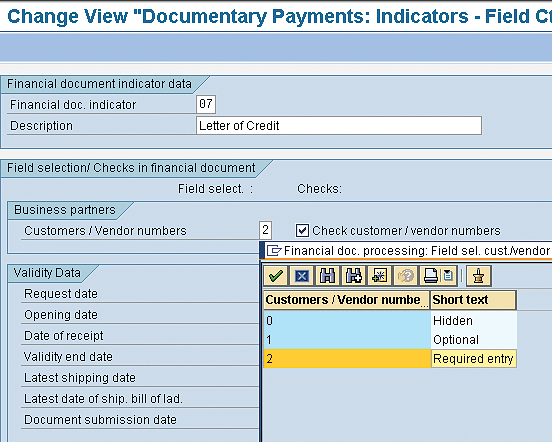
Figure 12
Define indicators for financial documents
The fields under Field select are used to indicate if a field should be Hidden, Optional, or Required entry in the financial document based on requirements (Figure 13). The check boxes under Checks are required to be selected if the field would be required as criteria to check SD documents to which the letter of credit (financial document) is assigned (Figure 13).
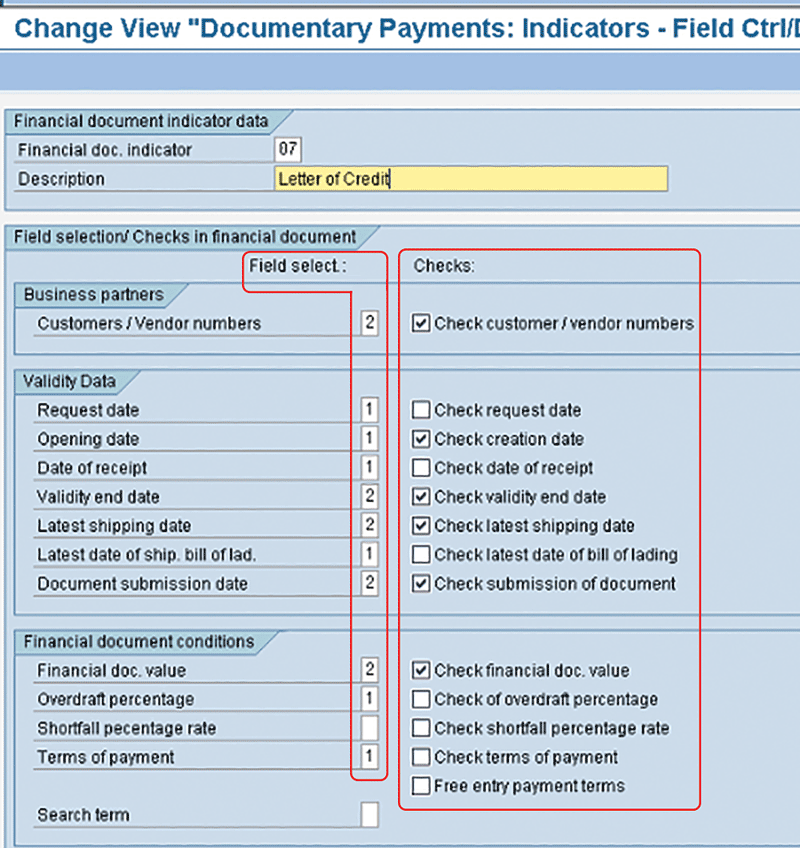
Figure 13
Field Select and Check sections for a financial document
After defining the indicators for financial documents, click the back icon to return to the list of defined indicators for financial documents and save your configuration by clicking the save icon. Figure 14 shows the list of the defined indicators for financial documents.
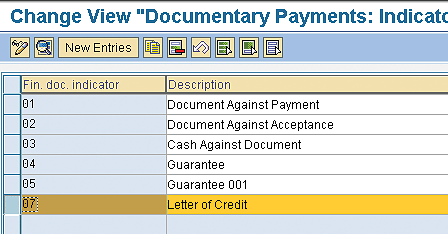
Figure 14
The list of defined indicators for financial documents
Define Bank Indicators
Bank indicators are used to set up groupings of bank functions that can be assigned to a letter of credit (financial document).
To define bank indicators under Basic Settings, follow SAP IMG menu path Sales and Distribution > Foreign Trade/Custom > Documentary Payment > Basic Settings > Define Bank Indicators. Click the execute icon beside the Define Bank Indicators node to display a list of bank indicators (Figure 15).
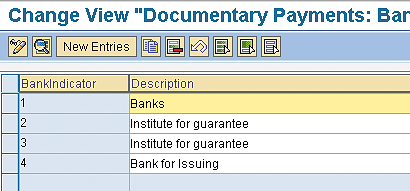
Figure 15
The list of bank indicators
To define new bank indicators, click the New Entries button or click the copy icon. This action displays the screen in Figure 16. For my example, define bank indicators for confirmed and unconfirmed letters of credit. To define a bank indicator for a confirmed letter of credit, enter C in the Bank indicator field and Banks for Confirmed Letters of Credit in the Description field. Click the save icon to save your data. Repeat the same process to define banks for unconfirmed letters of credit. (The value for the unconfirmed bank indicator is U, and the description is Banks for Unconfirmed Letters of Credit.)

Figure 16
Define bank indicators
After you define the bank indicators, click the back icon to return to the list of defined bank indicators and save your configuration by clicking the save icon. Figure 17 shows the list of the defined bank indicators.

Figure 17
The list of defined bank indicators
At this point, the required basic settings for the Documentary Payments component have been configured. The next step is to set up the relationships or the assignment of the basic settings.
Assign Documents to the Financial Indicator
The several documents to be presented should be assigned to the appropriate financial documents indicators. For my example, assign the relevant documents to be presented to the letter of credit financial document indicator.
To assign documents to the financial indicator under relationships, follow SAP IMG menu path > Sales and Distribution > Foreign Trade/Customs > Documentary Payments > Relationships > Assign Documents to Financial Document Indicator. Click the execute icon beside the Assign Documents to Financial Document Indicator node to display the list of assigned documents to the financial document indicator (Figure 18).

Figure 18
The list of assigned documents to the financial document indicator
To assign new documents to the financial document indicator, click the New Entries button or click the copy icon. For my example, assign the sight draft, time draft, and license, as well as bill of lading, invoice, export documents, insurance certificate, and airway bill, to the letter of credit. Figure 19 shows the assignment of the sight draft to the letter of credit financial document. The Letter of Credit option is selected from the drop-down list of options in the FD indic. (financial document indicator) column.
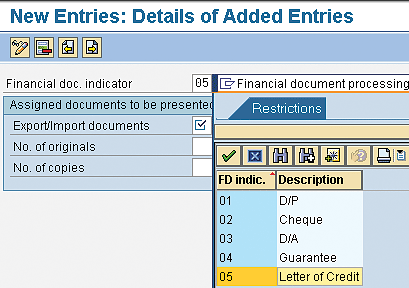
Figure 19
Select a financial document indicator
Next, select S for the sight draft document from the drop-down list of options in the Export/Import documents field (Figure 20).

Figure 20
Assign a relevant document to the financial document indicator
Figure 21 shows that the sight draft document is assigned to the financial document indicator with the settings to that document entered as 1 for the original copy and 1 for other copies as required.
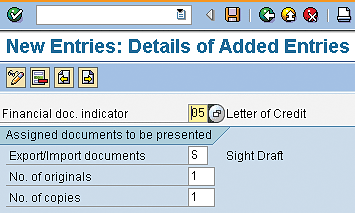
Figure 21
The sight draft assigned to letter of credit
After you assign the sight draft to the letter of credit, click the next entry icon to assign other documents to be presented following the same process used in assigning the sight draft to the letter of credit.
After assigning the documents to be presented to the letter of credit, click the back icon to return to the list of assigned documents to be presented and save your configuration by clicking on the save icon. Figure 22 shows the list of the assigned documents to be presented to the letter of credit.

Figure 22
List of assigned documents to financial document indicators
Specify Control of Banks in the Financial Document
This setup is used to group bank functions by assigning the various bank functions to the bank indicators.
To specify control of banks in a financial document under relationships, execute transaction code VX54 or follow SAP IMG menu path > Sales and Distribution > Foreign Trade/Customs > Documentary Payments > Relationships > Specify Control Of Banks In Financial Document. Click the execute icon beside the Specify Control Of Banks In Financial Document node to display the list of specified control of banks in the financial document (Figure 23).
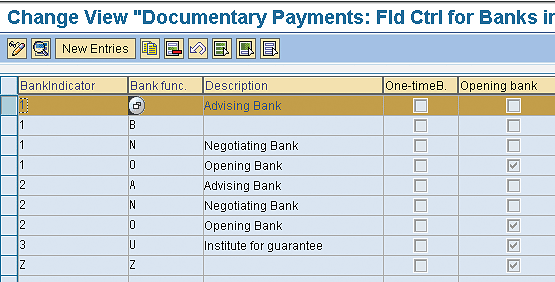
Figure 23
List of assigned bank functions to bank indicators
To specify or assign new bank functions to bank indicators that were defined earlier, click the New Entries button or click the copy icon. For my example, assign banks for a confirmed letter of credit and banks for an unconfirmed letter of credit (bank indicators) to the opening bank and Advising Bank and Negotiating Bank (Bank Functions), respectively. Figure 24 shows the assignment of banks for a confirmed letter of credit to the advising bank by selecting the respective fields and using the F4 key on the keyboard to drop the option list, and then selecting the appropriate value in both cases.

Figure 24
Assign a bank function to the bank indicator
Also in Figure 24, the One-time bank or Opening bank check box can be selected if required. Select the One-time bank check box if you want to allow a bank function without a bank master in the financial document master. The Opening bank check box is selected if the bank is going to function as an opening bank. You can also indicate the maximum number of banks per bank function in the bank tab in the financial document master using the Max. no. of banks (maximum number of banks) field. In the External financial doc. no. (external financial document number) and Bank Charges fields, you can set the external financial document number and bank charges as Hidden, Optional, or Required entry by selecting 0, 1, or 2, respectively, from a drop-down list when you click these fields.
After the assignment of banks for a confirmed letter of credit to the advising bank, click the next entry icon to assign other bank functions to bank indicators following the same process used in assigning the banks for a confirmed letter of credit to the advising bank.
After assigning the bank functions to bank indicators, click the back icon to return to the list of assigned bank functions to bank indicators and save your configuration by clicking the save icon. Figure 25 shows the list of the assigned bank functions to bank indicators.

Figure 25
List of assigned bank functions to bank indicators
Specify Financial Document Control
The financial document control function is used to assign the financial document type and financial document category to the financial document indicator and bank indicator.
To specify financial document control under Relationships, execute transaction code VX53 or follow SAP IMG menu path > Sales and Distribution > Foreign Trade/Customs > Documentary Payments > Relationships > Specify Financial Document Control. Click the execute icon beside the Specify Financial Document Control node to display the list of assigned financial document controls (Figure 26).

Figure 26
The list of assigned financial document controls
To specify or assign a new financial document control, which assigns a financial document type and financial document category to a financial document indicator and bank indicator, click the New Entries button or click the copy icon. For my example, assign a financial document control for an irrevocable confirmed letter of credit and an irrevocable unconfirmed letter of credit.
To complete this step, select each field shown in Figure 27 and then press the F4 key on your keyboard to choose the appropriate value from a drop-down list of options. Figure 27 shows the values for assigning a financial document control for an irrevocable confirmed letter of credit.
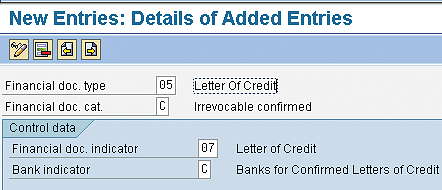
Figure 27
Assign a financial document control
After you assign a financial document control for an irrevocable confirmed letter of credit, click the next entry icon to assign other financial document controls following the same process that you used in assigning the financial document control for an irrevocable confirmed letter of credit.
After assigning the financial document control, click the back icon to return to the list of assigned financial document controls and save your configuration by clicking the save icon. Figure 28 shows the list of the assigned financial document controls.
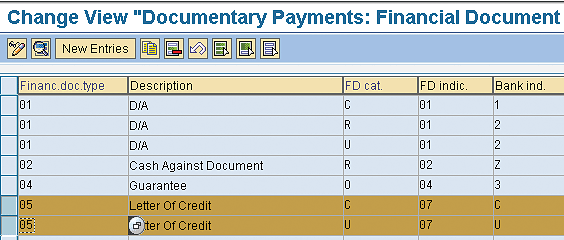
Figure 28
List of assigned financial document controls
The setup for s relationship in documentary payment is complete at this point. The next step is to set up risk management for financial documents.
Define Forms of Payment Guarantee
You need to define forms of payment guarantees, such as financial documents and payment cards to control how the payment for an SD document item is guaranteed.
To define forms of payment guarantees under Risk Management for Financial Documents, execute transaction code VI52 or follow SAP IMG menu path Sales and Distribution > Foreign Trade/Customs > Documentary Payments > Risk Management for Financial Documents > Define Forms of Payment Guarantee. Click the execute icon beside the Define Forms of Payment Guarantee node to display the list of defined forms of payment guarantee (Figure 29).
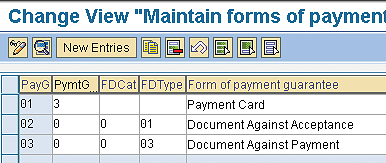
Figure 29
The list of defined forms of payment guarantee
To define new forms of payment guarantee, click the New Entries button or click the copy icon. For my example, define forms of payment guarantee for an irrevocable confirmed letter of credit and an irrevocable unconfirmed letter of credit.
To complete this step, select each field shown in Figure 30 and press the F4 key on your keyboard to choose the appropriate value from a drop-down list of options. Figure 30 shows the values for the definition of a form of payment guarantee for an irrevocable confirmed letter of credit.

Figure 30
Define a form of payment guarantee
After you define a form of payment guarantee for an irrevocable confirmed letter of credit, click the next entry icon to define other forms of payment guarantees by following the same process that you used to define a form of payment guarantee for an irrevocable confirmed letter of credit.
After you define a form of payment guarantee, click the back icon to return to the list of defined forms of payment guarantee and save your configuration by clicking the save icon. Figure 31 shows the list of the defined forms of payment guarantee.

Figure 31
The list of defined forms of payment guarantee
Define and Assign Payment Guarantee Schemas
Setting up this functionality helps the SD transaction determine which form of payment guarantee is allowed in the SD document.
To define and assign payment guarantee schemas under risk management for financial documents, follow SAP IMG menu path Sales and Distribution > Foreign Trade/Customs > Documentary Payment > Risk Management for Financial Documents > Define and Assign Payment Guarantee Schemas. Click the execute icon beside the Define and Assign Payment Guarantee Schemas node to display the list of activities used for defining and assigning payment guarantee schemas (Figure 32).
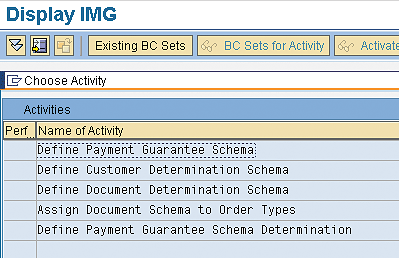
Figure 32
The list of activities for defining and assigning payment guarantee schemas
Double-click Define Payment Guarantee Schema to display a list of defined payment guarantee schemas (Figure 33).

Figure 33
The list of defined payment guarantee schemas
To define a payment guarantee schema, click the New Entries button or click the copy icon. This action opens the screen in Figure 34. For my example, define a payment guarantee schema for a letter of credit. To complete this step, enter 000004 in the field under the first column in Figure 34 and enter a description (Letter of Credit) in the second field.

Figure 34
Define a payment guarantee schema
After you define the payment guarantee schema, click the back icon to return to the list of defined payment guarantee schemas as shown in Figure 33.
Now you need to assign the forms of payment guarantee to be allowed in the payment guarantee schema for letter of credit. To complete this step, select the Letter of Credit payment guarantee schema in Figure 34 and click the Forms of payment guarantee folder in the left pane as shown in Figure 35.

Figure 35
Assign the forms of payment guarantee to be allowed in the payment guarantee schema for letter of credit
To assign new forms of payment guarantee to a new payment guarantee schema (letter of credit), click the New Entries button. This action opens the screen in Figure 36. For my example, assign an irrevocable confirmed letter of credit and an irrevocable unconfirmed letter of credit forms of payment guarantee to the payment guarantee schema for a letter of credit.

Figure 36
Assign forms of payment guarantee
To assign an irrevocable confirmed letter of credit form of payment guarantee to the payment guarantee schema for a letter of credit, populate the fields shown in Figure 36.
After you assign a form of payment guarantee for an irrevocable confirmed letter of credit, click the next entry icon to define other forms of payment guarantee by following the same process that you used in defining forms of payment guarantee for an irrevocable confirmed letter of credit.
After you define the forms of payment guarantee, click the back icon to return to the list of defined forms of payment guarantee and save your configuration by clicking the save icon. Figure 37 shows the list of the defined forms of payment guarantee assigned to letter of credit payment guarantee schema.

Figure 37
List of assigned forms of payment guarantee
Define Customer Determination Schema
This step determines which payment guarantee procedure the system picks by default automatically if you enter a sales order for the customer. To complete this step, follow the instructions to display the screen shown in Figure 32 and then double-click Define Customer Determination Schema to display a list of defined customer determination schemas (Figure 38).
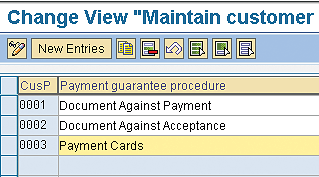
Figure 38
The list of defined customer determination schemas
To define a new customer determination schema, click the New Entries button or click the copy icon. This action opens the screen in Figure 39. For my example, define a customer determination schema for a letter of credit. To complete this step, enter 0004 in the field under the first column in Figure 39 and a description (Letter of Credit) in the field under the second column.

Figure 39
Define a customer determination schema
After you define a customer determination schema for a letter of credit, click the back icon to return to the list of defined customer determination schema and save your configuration by clicking on the save icon. Figure 40 shows the list of the defined customer determination schemas.

Figure 40
List of defined customer determination schemas
Define Document Determination Schema
This step determines which payment guarantee procedure the system automatically uses for a sales document type. To complete this step, follow the instructions to display the screen shown in Figure 32 and then double-click Define Document Determination Schema to display a list of defined document determination schema (not shown).
For my example, you use the default defined Document Determination Schema (Figure 41), but to define a new define document determination schema, click the New Entries button or click the copy icon.
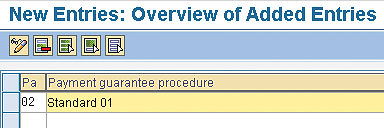
Figure 41
Defined document determination schema
Assign Document Schema to Order Types
When a document schema is assigned to an order type, the Payment Guarantee Procedure field is activated in that document and the payment guarantee procedure is determined by the assigned order document. To complete this step, follow the instructions to display the screen shown in Figure 32 and then double-click Assign Document Schema to Order Types to display a list of document types (Figure 42).

Figure 42
List of document types
In the field under the Pa (payment guarantee) column, use the F4 key on the keyboard to display a drop-down list of document payment guarantee procedures. Select and assign an option as appropriate. In my example, only one document payment guarantee procedure (Standard) is available.
After you assign the document payment procedure schema to the order type, in this case Sales Order (OR), save your configuration by clicking the save icon (Figure 43).

Figure 43
List of assigned order types
Define Payment Guarantee Schema Determination
With this activity in this setup, how the Payment Guarantee Procedure is determined automatically from the order document and customer master data is defined. To complete this step, follow the instructions to display the screen shown in Figure 32 and then double-click Define Payment Guarantee Schema Determination to display a list of defined payment guarantee schema determinations (Figure 44).

Figure 44
The list of defined payment guarantee schema determinations
To define a new payment guarantee schema determination, click the New Entries button or click the copy icon. This action opens the screen in Figure 45. For my example, define a payment guarantee schema determination with the letter of credit payment guarantee procedure (000004), letter of credit customer payment guarantee schema (0004), and the standard document payment guarantee schema defined earlier (Figure 45).

Figure 45
Define a payment guarantee schema determination
After you define the payment guarantee schema determination, click the back icon to return to the list of defined payment guarantee schema determinations and save your configuration by clicking the save icon. Figure 46 shows the list of the defined payment guarantee schema determinations.

Figure 46
The list of defined payment guarantee schema determinations
With this end-to-end configuration, your SAP ERP system is now ready to run the Cockpit for Documentary Payments, which is leveraged to transact international trade with very low risk payment guarantee procedures such as letter of credit.
How to Use the SAP Documentary Payments Cockpit Functionalities: A Letter-of-Credit Scenario
To use the SAP Cockpit for Documentary Payments, you need to define a customer master record and a bank master record should have been defined.
At the international sales process stage where the advising bank has verified the letter of credit and any other documents given by the opening bank on behalf of the customer and has sent these documents to the seller or exporter, the activity for creating the financial document in the SAP system is triggered. The financial document (Letter of Credit) is created in the SAP system via the Cockpit for Documentary Payments.
To create a financial document in the SAP system via the Cockpit for Documentary Payment, execute transaction code ENLO or follow SAP menu path > Logistics > Sales and Distribution > Foreign Trade/Customs > Payment Guarantee > Cockpit – Documentary Payments. Click the Cockpit – Documentary Payments node to display the Cockpit for Documentary Payments (Figure 47).

Figure 47
The Cockpit for Documentary Payments screen
Here are some of the functionalities of the Cockpit for Documentary Payments:
- Maintain financial documents: This segment contains the date required to create a new financial document or to maintain and display an existing financial document.
- Monitoring: The monitoring activities include financial documents; this function is used to generate a list of financial documents in the SAP system. The Blocked documents function is used to generate list of documents that have been blocked during SD transactions because of an inconsistency check. The Assigned documents function is used to generate SD documents to which financial documents have been assigned.
- Controlling: The controlling activities include the Customer master function, which checks consistency in the customer master for relevant foreign trade data that has been maintained. The Print monitoring function is used to show all invoices and documents assigned to financial documents.
- Simulation: The simulation activity is used to simulate sales documents assignment criterion to financial documents.
- Environment: Under this segment, you can create, change, and display the bank master and credit master.
To create a financial document via the Cockpit for Documentary Payments, click Documentary Payments on the menu bar and then follow menu path Financial documents > Create to create a new financial document (Figure 48).
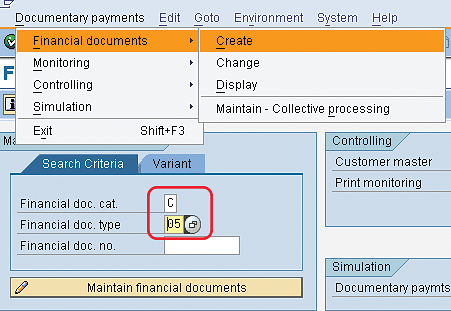
Figure 48
Create a financial document via the Cockpit for Documentary Payments
When you click Create in Figure 48, the screen in Figure 49 opens in which you input the relevant data. For my example, you create an irrevocable confirmed letter of credit (financial document) in Company Code 1000.
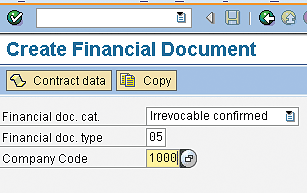
Figure 49
Create a financial document
After the relevant data has been entered, click the enter icon (the green check mark) or press the Enter key on your keyboard to open the Create Financial Document Overview screen (Figure 50).

Figure 50
Maintain general data
Populate the Customer and Ship-to party fields, and in the General data tab, input data for the opening bank and the financial document value. In my example, the financial document value is €2,000,000 with an allowed overdraft of 1 percent (€20,000).
Now click the Dates/Delivery dates tab and input the dates accordingly, including the agreed-upon Incoterms, as shown in Figure 51.

Figure 51
Maintain data in the Dates/Delivery dates tab
Now click the Documents tab to check if the required documents have been maintained. The documents are determined automatically based on the configuration in customizing. You could add more documents manually if such documents were not defined in the customizing (Figure 52).
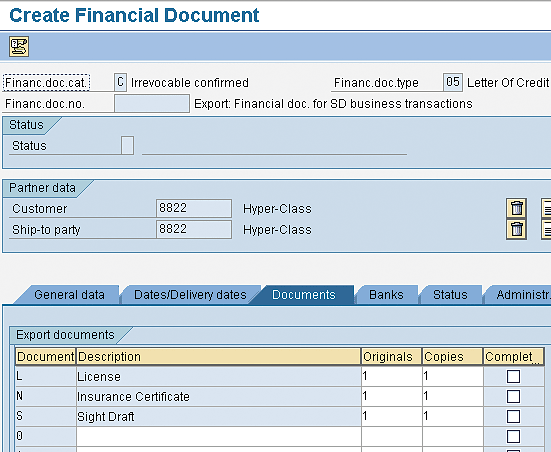
Figure 52
Maintain documents to be presented
Next, click the Bank tab to maintain bank data. The advising bank is Vigatrust in the United States with a 1 percent charge and a corresponding bank to the opening bank Vigatrust in Germany (Figure 53).
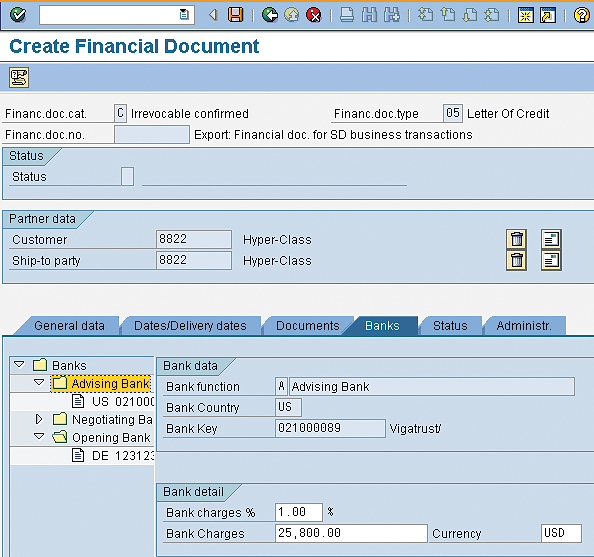
Figure 53
Maintain bank function data
When you click the Status tab, you observe that the document status is still blank (Figure 54).

Figure 54
Financial document status
Note
There are five statuses for financial documents:
- A – Document has been created (this status implies that the financial document has be created).
- B – Document is incomplete - further papers required (this status implies that more information is required for the financial document to be complete).
- C - Notification that document has been sent (this status implies that the document has been sent)
- D - Document is available and can be used (this status means the financial document has been activated and can be assigned to a sales document).
- E - Change in document has been submitted (this status implies that the financial document cannot be assigned to a sales document unless the status is changed to D.
- Z - Document is closed and can be reorganized.
Before you save the document, first check the log for completeness. Click the log icon  on the application toolbar in Figure 54 to display the log (Figure 55). If the document is complete you see the message shown in Figure 55.
on the application toolbar in Figure 54 to display the log (Figure 55). If the document is complete you see the message shown in Figure 55.

Figure 55
Message indicating that the document is complete
Click the continue icon (the green check mark) or press the Enter key on your keyboard. Next click the save icon (not shown). The system then displays a pop-up message indicating that Status A is set (Figure 56).

Figure 56
A status message
Finally, the financial document is saved and the number is generated as shown in Figure 57.

Figure 57
Financial document saved
To check the status of the financial document created via the maintain transaction in the SAP Cockpit for Documentary Payments, input the relevant data in the fields shown in Figure 58 and click the Maintain financial documents button. To go to the SAP Cockpit for Documentary Payments use transaction code ENLO.

Figure 58
Maintain a financial document
In the next screen, you can see that the status of the financial document has changed to A and the date for creation of the financial document has been recorded (Figure 59).
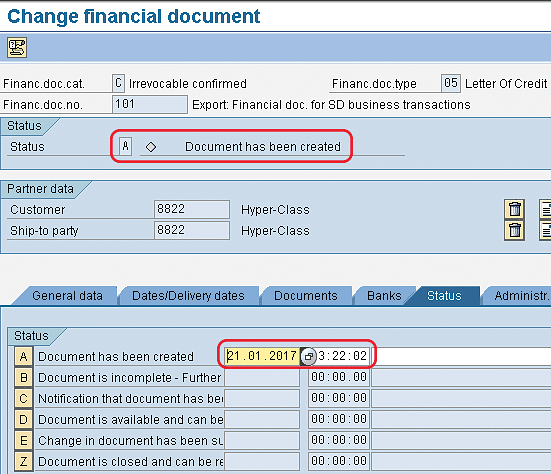
Figure 59
Check the financial document status
This is basically how the financial document is created via the Cockpit for Documentary Payments and the data maintained here is used by the system to check any sales order for this customer that this financial document will be assigned to after it has been activated (status changed to D).
How to Activate a Financial Document
A financial document can be activated so that it is ready for use during a sales transaction by setting the financial document status to D (document is available and can be used).
I now explain how to activate Financial Document 101 (Irrevocable Confirmed Letter of Credit) via the SAP Cockpit for Documentary Payments by setting the Status to D (Document is available and can be used).
In the Cockpit for Documentary Payments, click the Maintain financial documents button (Figure 58). When the financial document opens, click the Status tab as shown in Figure 60. (Observe that the status is still A).

Figure 60
Financial document with status A
Click the Status field and select D and it shall be activated. Note that after clicking D the status indicator changes to D and the gray icon beside the Status field turns to green (Figure 61).
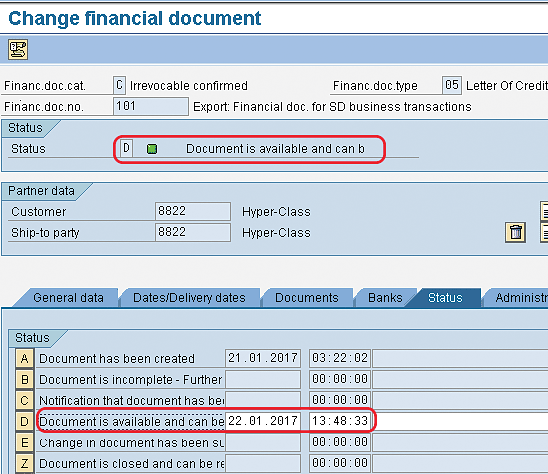
Figure 61
Financial document with status D (activated)
Now that the financial document is activated and ready for use in the sales document, you can test the configuration by creating a sales order and assigning financial document 101 to it for customer 8822 (Hyper-Class). To create a sales order execute transaction code VA01 or follow SAP menu path > Logistics > Sales and Distribution > Sales > Order > VA01 Create. This path opens the screen in Figure 62.
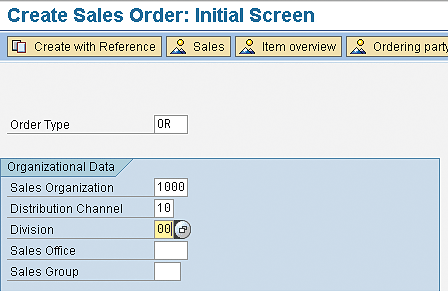
Figure 62
The Create Sales Order Initial Screen
Input the necessary data in the fields under the Organizational Data and enter a value for the document type in the Order Type field as shown in Figure 62. Click the enter icon (not shown) or press the Enter key on your keyboard to save your data.
In the Create Sales Order Overview screen, enter the necessary business data for customer 8822 (Hyper-Class) as shown in Figure 63.
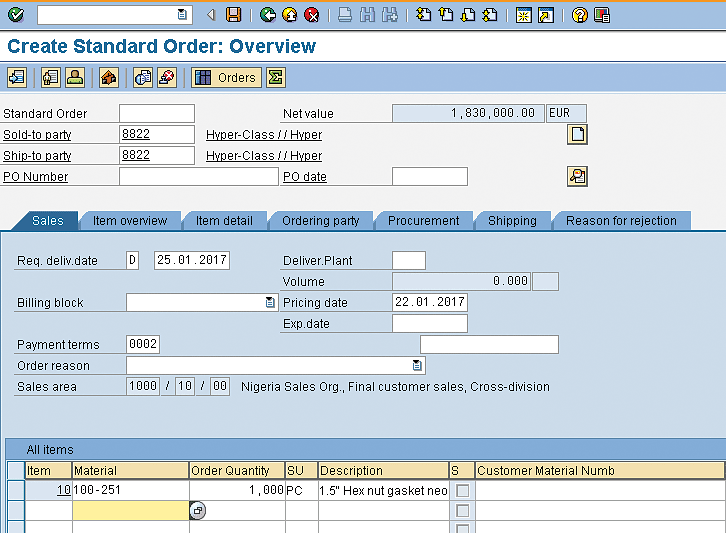
Figure 63
The Create Standard Order Overview screen
To assign a financial document to a sales order, click Goto in the menu bar and then follow menu path Header (select Item if the financial document is to be assigned to an item) > Billing (Figure 64).

Figure 64
Assign a financial document to a sales order
In the Risk Management section of the Billing Document tab (not shown), assign the appropriate payment guarantee procedure (00004 - letter of credit) and the financial document number 101. Click the save icon to save the sales order. The information screen in Figure 65 then pops up indicating that the check result was not ok.
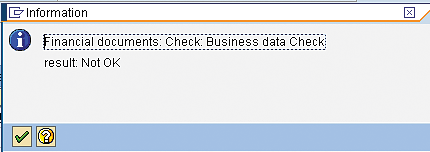
Figure 65
The Information screen
Click the continue icon and you then see a message indicating that the sales order has been saved (Figure 66).

Figure 66
Sales order saved in the system
The sales order is then blocked for delivery because the consistency check was not ok (Figure 67).
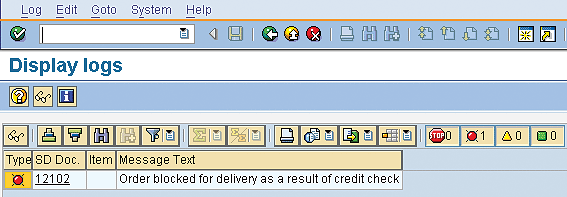
Figure 67
Log for sales order block for delivery
The reason the sales order failed the consistency check with the assigned financial document is because while the financial document has a stipulated value of 2,000,000 euros and an overdraft of 1 percent, which is 20,000 euros, the sales order has a total value of 2,122,800 euros, which is above the financial document value and the overdraft limit (Figure 68).
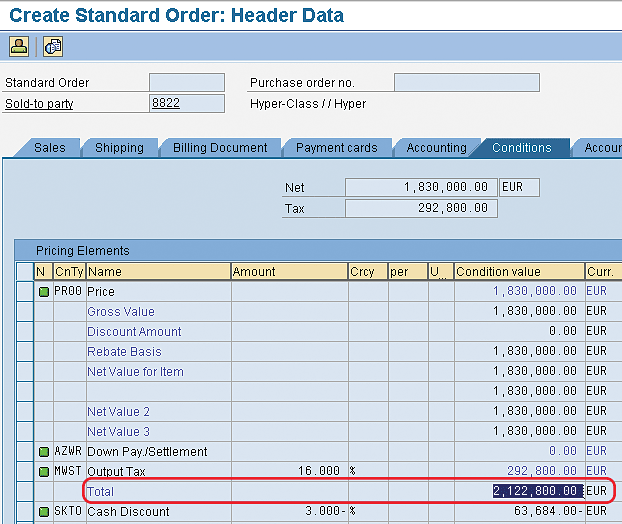
Figure 68
Sales order pricing schema
The financial document is used as a control to ensure that the sales transaction for an international customer does not exceed agreed-upon value, and that it is consistent with the agreed-upon business terms. The financial document is also used as a payment guarantee to ensure customers make their complete payment as at when due.
A Tip on How to Activate Documentary Payment for Item Categories
You can make a documentary payment active for item categories. To complete this step, follow SAP IMG menu path Sales and Distribution > Foreign Trade/Customs > Documentary Payment > Activate Documentary Payments per Item Category. This is recommended if an item category has been created particularly for foreign trade for which documentary payment is required.
Patrick Imhen
Patrick Imhen is a business analyst and a certified SAP ERP consultant with proficient knowledge, skills, and experience in Materials Management (MM), Sales and Distribution (SD) and Plant Maintenance (PM) gathered from successful SAP implementations projects, support, training, business process analysis, modeling, unit testing, and integration testing. He has profound understanding of the supply chain process across industries and helps organizations cut the cost of operation and improve process optimization. He has more than 10 years’ experience in the business environment and six years’ experience in the SAP domain.
You may contact the author at patrick.imhen@zocoderesources.com.
If you have comments about this article or publication, or would like to submit an article idea, please contact the editor.




































































